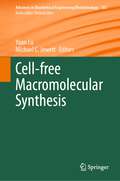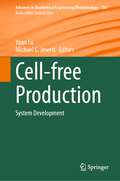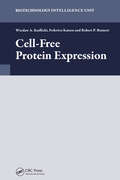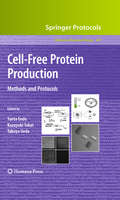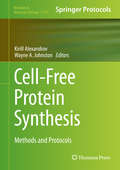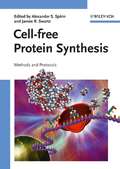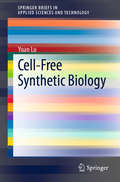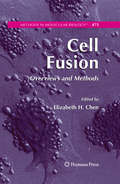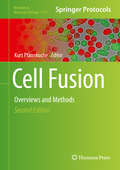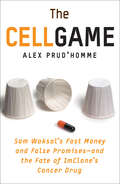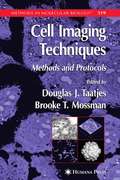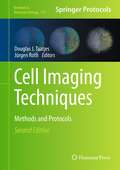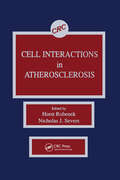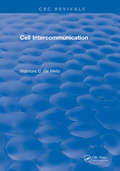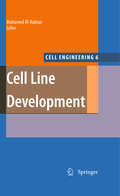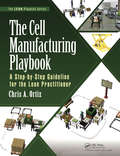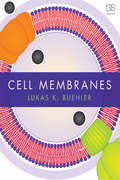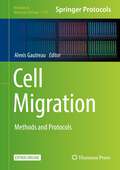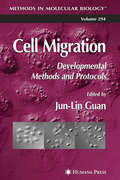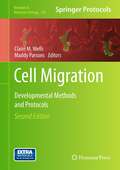- Table View
- List View
Cell-free Macromolecular Synthesis (Advances in Biochemical Engineering/Biotechnology #185)
by Yuan Lu Michael C. JewettThis book reviews cell-free production systems, exploring the frontiers in cellular engineering and biotechnology. With contributions from experts in the field, the book offers a comprehensive and up-to-date account of the latest advancements and practical applications. The volume covers a diverse range of topics, beginning with an in-depth analysis of cell-free display techniques for protein evolution, shedding light on the methodologies used to engineer proteins for diverse purposes, followed by an examination of bottom-up synthetic biology employing cell-free protein synthesis. Additionally, it investigates the intricacies of the cell-free synthesis of metalloproteins, elucidating the unique properties and functionalities of these biologically important molecules.In this book, particular attention is given to the integration of cell-free production systems with droplet microfluidics, a pioneering approach that has revolutionized research activities in both academic and industrial settings. Readers will also discover the latest advancements in cell-free protein synthesis and immobilization, and find out more about the eCell technology, which combines cell-free protein synthesis with bio-sensing and remediation, revolutionizing critical areas of study in biotechnology. Together with the companion volume entitled “Cell-free Production: System Development”, both books highlight the research progresses on the basic and applied research of cell-free production systems in the last few years, and are invaluable resources for scholars, researchers, and bioengineers. This book also appeals to enthusiasts of synthetic biology.
Cell-free Production: System Development (Advances in Biochemical Engineering/Biotechnology #186)
by Yuan Lu Michael C. JewettThis book reviews the development of cell-free production platforms and offers an authoritative perspective of the latest advances and methodologies in cell-free production systems. Readers will discover the biomanufacturing potential of in vitro biotransformation (ivBT) employing purified cascade multi-enzymes, the development of hydrogel-based multi-enzymatic systems for biosynthesis, and novel insights into the optimization of biocatalytic processes. Additionally, the book explores the cell-free production and regeneration of cofactors, shedding light on strategies to enhance the efficiency and sustainability of cellular processes. In this book, particular attention is given to the progress of cell-free in vitro evolution techniques for optimizing enzyme performance, and the book also presents the integration of rapid and finely-tuned expression systems for deployable sensing applications, revolutionizing the field of biosensing. The synthesis and electrophysiological analysis of multipass voltage-gated ion channels tethered in microsomal membranes are explored, providing a deep understanding of cellular function at the molecular level. Lastly, the book covers compartmentalized cell-free expression systems for building synthetic cells, showcasing the potential for constructing artificial cellular systems with unique functionalities. Given its breadth, this book appeals to academics, researchers, and professionals interested in the forefront of biotechnology, and together with the companion volume “Cell-free Macromolecular Synthesis”, both books highlight the research progresses on the basic and applied research of cell-free production systems in the last few years, being invaluable resources in the field.Chapter “Cell-free synthesis and electrophysiological analysis of multipass voltage-gated ion channels tethered in microsomal membranes” is available open access under a Creative Commons Attribution 4.0 International License via link.springer.com.
Cell-Free Protein Expression
by W. Antoni KudlickiFollowing its inception in the 1950s, cell-free protein synthesis made a tremendous impact on the basic life sciences. The use of cell-free systems was key to understanding molecular mechanisms underlying one of the most complicated processes found in nature: protein translation. Since this time, aggressive cutting-edge research and stiff commerica
Cell-Free Protein Production: Methods and Protocols (Methods in Molecular Biology #607)
by Takuya Ueda Yaeta Endo Kazuyuki TakaiDuring the past decade as the data on gene sequences and expression patterns rapidly accumulated, cell-free protein synthesis technology has also experienced a revolution, becoming a powerful tool for the preparation of proteins for their functional and structural analysis. In Cell-Free Protein Production: Methods and Protocols, experts in the field contribute detailed techniques, the uses of which expand deep into the studies of biochemistry, molecular biology, and biotechnology. Beginning briefly with basic methods and historical aspects, the book continues with thorough coverage of protein preparation methods, the preparation of proteins that are generally difficult to prepare in their functional forms, applications of the cell-free technologies to protein engineering, as well as some methods that are expected to constitute a part of future technologies. Written in the highly successful Methods in Molecular BiologyTM series format, the chapters include introductions to their respective topics, lists of the necessary materials and reagents, step-by-step, readily reproducible laboratory protocols, and notes on troubleshooting and avoiding known pitfalls. Authoritative and cutting-edge, Cell-Free Protein Production: Methods and Protocols aims to help researchers continue the growth of the vital exploration of cell-free sciences and technologies in order to better understand the dynamic lives of cells.
Cell-Free Protein Synthesis: Methods and Protocols (Methods in Molecular Biology #1118)
by Kirill Alexandrov Wayne A. JohnstonCell-free protein expression promises to narrow the technological gap between DNA and protein technologies and provide a platform for broad application of synthetic biology principles in the Life Sciences. It is a rapid and high throughput methodology for the conversion of DNA encoded genetic information into protein-mediated biochemical activities. "Cell-Free Protein Synthesis: Methods and Protocols "brings together the key opinion leaders of cell-free technology development and provides case studies and detailed protocols for the application of cell-free methodology. Chapters cover the main directions in the development of cell-free technologies including several recently developed cell-free systems, as well as a number of applications of cell-free systems ranging from discovery of biofuel enzymes to "in vitro" assembly of viruses. Written in the successful "Methods in Molecular Biology" series format, chapters include introductions to their respective topics, lists of the necessary materials and reagents, step-by-step, readily reproducible protocols, and notes on troubleshooting and avoiding known pitfalls. Authoritative and easily accessible, "Cell-Free Protein Synthesis: Methods and Protocols "seeks to serve a wide variety of scientists with its well-honed methodologies.
Cell-free Protein Synthesis: Methods and Protocols
by Alexander S. Spirin James R. SwartzWith its detailed description of membrane protein expression, high-throughput and genomic-scale expression studies, both on the analytical and the preparative scale, this book covers the latest advances in the field. The step-by-step protocols and practical examples given for each method constitute practical advice for beginners and experts alike.
Cell-Free Synthetic Biology (SpringerBriefs in Applied Sciences and Technology)
by Yuan LuThis book describes advanced studies in cell-free synthetic biology, an emerging biotechnology that focuses on cell-free protein synthesis and cell-free systems for fundamental and industrial research in areas such as genetic circuit design, small-molecule synthesis, complicated-macromolecule synthesis, unnatural-macromolecule synthesis, high-throughput screening, artificial cells, and biomaterials. Cell-free synthetic biology is now an integral part of developing fields like nanotechnology, materials science, and personalized medicine. The book discusses the main research directions in the development of cell-free systems, as well as a number of applications of cell-free synthetic biology, ranging from structural biology to the human health industry. It is intended for students and researchers in life sciences, synthetic biology, bioengineering, and chemical engineering.
Cell Fusion: Overviews and Methods (Methods in Molecular Biology #475)
by Elizabeth H. ChenExciting work in the past decade has revealed commonalities and differences among individual cell fusion events. In Cell Fusion: Overviews and Methods, a team of leading experts provide a collection of overviews that outline our current understanding of cell fusion and methods that present classic and state-of-the-art experimental approaches in a variety of systems. Divided into two convenient parts, the volume begins with nine overviews which describe different cell fusion events in models from yeast to mammals, and it continues with thirteen chapters illustrating commonly used methods to assay cell fusion in particular systems. As a part of the highly successful Methods in Molecular BiologyTM series, these methods chapters compile step-by-step, readily reproducible protocols with lists of the necessary materials and reagents, along with tips on troubleshooting and avoiding known pitfalls. Cutting-edge and user-friendly, Cell Fusion: Overviews and Methods serves as a comprehensive resource for anyone, expert or novice, interested in the fascinating biological process of cell fusion.
Cell Fusion: Overviews and Methods (Methods in Molecular Biology #1313)
by Kurt PfannkucheThis volume details protocols on detection and analysis of fusion events in various cell types in vitro and in vivo. Additional, protocols aim to facilitate the future highly relevant process of engineering cells for specific purposes, such as generation of transgenic embryos and development of hybrid cells, in order to tackle specific tasks in cell biology and medicine. Written for the Methods in Molecular Biology series, chapters include introductions to their respective topics, lists of the necessary materials and reagents, step-by-step, readily reproducible laboratory protocols, and tips on troubleshooting and avoiding known pitfalls. Practical and authoritative, Cell Fusion: Overviews and Methods, Second Edition serves as an ideal reference on cell fusion and laboratory protocols.
Cell Fusion in Health and Disease: II: Cell Fusion in Disease (Advances in Experimental Medicine and Biology #950)
by Thomas Dittmar Kurt S. ZänkerAlthough cell fusion is an omnipresent process in life, to date considerably less is still known about the mechanisms and the molecules being involved in this biological phenomenon in higher organisms. In Cell Fusion in Health and Disease Vol 1 & Vol 2 leading experts will present up-to-date overviews about cell fusion in physiological and patho-physiological processes, which further covers the current knowledge about cell fusion-mediating molecules. Volume 1 deals with Cell Fusion in Health and will cover aspects of cell fusion in fertilization, placentation, in C. elegans, in skeletal muscle development and tissue repair, and the use of cell fusion for cellular reprogramming and cancer vaccine development. Volume 2 focuses on Cell Fusion in Disease with a particular emphasis on the role of cell fusion in cancer development and progression. Thus, Cell Fusion in Health and Disease Vol 1 & Vol 2 represents a state-of-the-art work for researchers, physicians or professionals being interested in the biological phenomenon of cell fusion and beyond.
The Cell Game: Sam Waksal's Fast Money and False Promises—and the Fate of ImClone's Cancer Drug
by Alex Prud'hommeThe “chilling tale” of ImClone Systems, its promising cancer drug, Erbitux, and the insider trading scandal that ensnared Martha Stewart (U.S. News & World Report).The Cell Game is the quintessential business saga of the late 1990s. It's the story of big money and cutting-edge science, celebrity, greed, and slipshod business practices; the story of biotech hype and hope and every kind of excess.At the center of it all stands a single, enigmatic figure named Sam Waksal. A brilliant, mercurial, and desperate-to-be-liked entrepreneur, Waksal was addicted to the trappings of wealth and fame that accrued to a darling of the stock market and the overheated atmosphere of biotech IPOs. At the height of his stardom, Waksal hobnobbed with Martha Stewart in New York and Carl Icahn in the Hamptons, hosted parties at his fabulous art-filled loft, and was a fixture in the gossip columns. He promised that Erbitux would "change oncology," and would soon be making $1 billion a year.But as Waksal partied late into the night, desperate cancer patients languished, waiting for his drug to come to market. When the FDA withheld approval of Erbitux, the charming scientist who had always stayed just one step ahead of bankruptcy panicked and desperately tried to cash in his stock before the bad news hit Wall Street.Waksal served time in prison, the first of the Enron-era white-collar criminals to be sentenced. Yet his cancer drug has proved more durable than his evanescent profits.“A fast-paced, absorbing, and dramatic account . . . An important, excellent book that makes for fascinating reading.” —Library Journal
Cell Imaging Techniques: Methods And Protocols (Methods in Molecular Biology #319)
by Douglas J. Taatjes Brooke T. MossmanA diverse collection of state-of-the-art methods for the microscopic imaging of cells and molecules. The authors cover a wide spectrum of complimentary techniques, including such methods as fluorescence microscopy, electron microscopy, atomic force microscopy, and laser scanning cytometry. Additional readily reproducible protocols on confocal scanning laser microscopy, quantitative computer-assisted image analysis, laser-capture microdissection, microarray image scanning, near-field scanning optical microscopy, and reflection contrast microscopy round out this eclectic collection of cutting-edge imaging techniques now available. The authors also discuss preparative methods for particles and cells by transmission electron microscopy.
Cell Imaging Techniques: Methods and Protocols (Methods in Molecular Biology #931)
by Douglas J. Taatjes Jürgen RothCell Imaging is rapidly evolving as new technologies and new imaging advances continue to be introduced. In the second edition of Cell Imaging Techniques: Methods and Protocols expands upon the previous editions with current techniques that includes confocal microscopy, transmission electron microscopy, atomic force microscopy, and laser microdissection. With new chapters covering colocalization analysis of fluorescent probes, correlative light and electron microscopy, environmental scanning electron microscopy, light sheet microscopy, intravital microscopy, high throughput microscopy, and stereological techniques. Written in the highly successful Methods in Molecular BiologyTM series format, chapters include introductions to their respective topics, lists of the necessary materials and reagents, step-by-step, readily reproducible laboratory protocols, and tips on troubleshooting and avoiding known pitfalls Authoritative and cutting-edge, Cell Imaging Techniques: Methods and Protocols, Second Edition is an easily accessible volume of protocols to be used with a variety of imaging-based equipment likely available in a core imaging facility.
Cell-Inspired Materials and Engineering (Fundamental Biomedical Technologies)
by Daniel Packwood Dan Ohtan WangThis book highlights cutting-edge studies in the development of cell-inspired biomaterials and synthetic materials that manipulate cell functions and provide the next generation with contemporary tools for treating complex human diseases. It explores the convergence of synthetic materials with cell and molecular biology and surveys how functional materials, when patterned with spatial and temporal precision, can be used effectively to maintain cell proliferation and phenotype in vitro, to trigger specific cell functions, and to redirect cell-fate decisions. Human stem cells are a frequently discussed subject in this book. This is an ideal book for students, cell biologists, researchers interested in interdisciplinary research, and biomedical engineers. This book also: Highlights successfully developed technologies in cell engineering that make possible new therapeutic development for previously untreatable conditions Covers topics including bio-inspired micro patterning, DNA origami technology, synthetic NOS inspired by compartmentalized signaling in cells, and light-induced depolarization of the cell membrane Illustrates in detail the use of stem cells and synthetic scaffolds to model ethically sensitive embryonic tissues and organs
Cell Interactions in Atherosclerosis
by Horst Robenek Nicholas J. SeversCell Interactions in Atherosclerosis covers the scientific foundations of the most important disease inflicting the developed world today. It presents a collection of topical aspects on the general theme of cell interactions in atherosclerosis, providing authoritative, up-to-the-minute accounts of how new developments in cell biology have advanced our understanding of these cellular interactions. The book is amply illustrated with electron micrographs and light micrographs incorporating modern cytochemical procedures. Cell Interactions in Atherosclerosis will interest all medical and scientific professionals dealing with atherosclerosis and heart disease.
Cell Intercommunication
by Walmore C. De MelloThis important publication addresses intercellular communication in health and disease. It includes recent advances in morphology and chemical organization of gap junctions. It discusses the possible role of intercellular channels in excitable and non-excitable tissues. The book presents modulation of junctional permeability, as well as the possible role of cell communication in embryonic development and growth. The text concludes with a synthetic view of the role of gap junctions and potential implications to cardiology, oncology, and other areas of pathology. This volume is important to professionals in pharmacology, physiology, biochemistry, biomedical science, pathobiology, pathology, molecular genetics, toxicology and human development.
Cell Invasion
by Jyrki HeinoProvides an overview of cell invasion. Topics include information on the cellular matrix, cell surface integrins, matrix metalloproteinases and proteinases, and the interplay between protein families.
Cell Line Development (Cell Engineering #6)
by Mohamed Al-RubeaiMammalian cell lines command an effective monopoly for the production of therapeutic proteins that require post-translational modifications. This unique advantage outweighs the costs associated with mammalian cell culture, which are far grater in terms of development time and manufacturing when compared to microbial culture. The development of cell lines has undergone several advances over the years, essentially to meet the requirement to cut the time and costs associated with using such a complex hosts as production platforms. This book provides a comprehensive guide to the methodology involved in the development of cell lines and the cell engineering approach that can be employed to enhance productivity, improve cell function, glycosylation and secretion and control apoptosis. It presents an overall picture of the current topics central to expression engineering including such topics as epigenetics and the use of technologies to overcome positional dependent inactivation, the use of promoter and enhancer sequences for expression of various transgenes, site directed engineering of defined chromosomal sites, and examination of the role of eukaryotic nucleus as the controller of expression of genes that are introduced for production of a desired product. It includes a review of selection methods for high producers and an application developed by a major biopharmaceutical industry to expedite the cell line development process. The potential of cell engineering approch to enhance cell lines through the manipulation of single genes that play important roles in key metabolic and regulatory pathways is also explored throughout.
The Cell Manufacturing Playbook: A Step-by-Step Guideline for the Lean Practitioner (The\lean Playbook Ser.)
by Chris A. OrtizThis book describes how to effectively implement cell manufacturing. It covers the eight Wastes of Lean and the six Lean metrics that are recommended in each implementation and a description of what cell manufacturing is and its application to improving operational processes.
Cell Mechanics: From Single Scale-Based Models to Multiscale Modeling
by Arnaud Chauvière Luigi Prezigsi Claude VerdierUbiquitous and fundamental in cell mechanics, multiscale problems can arise in the growth of tumors, embryogenesis, tissue engineering, and more. Cell Mechanics: From Single Scale-Based Models to Multiscale Modeling brings together new insight and research on mechanical, mathematical, physical, and biological approaches for simulating the behavior
Cell Membrane Nanodomains: From Biochemistry to Nanoscopy
by Alessandra Iambi Diane S. LidkeCell Membrane Nanodomains: From Biochemistry to Nanoscopy describes recent advances in our understanding of membrane organization, with a particular focus on the cutting-edge imaging techniques that are making these new discoveries possible. With contributions from pioneers in the field, the book explores areas where the application of these novel
Cell Membranes
by Lukas BuehlerCell Membranes offers a solid foundation for understanding the structure and function of biological membranes. The book explores the composition and dynamics of cell membranes discussing the molecular and biological diversity of its lipid and protein components and how the combinatorial richness of both components explains the chemical, mechanical, and self-renewing properties of cell membranes. Cell Membranes is a valuable resource for advanced undergraduate students, graduate students, and professionals.
Cell Migration: Methods And Protocols (Methods In Molecular Biology #1749)
by Alexis GautreauThis volume covers various assays and techniques that have been developed to study and characterize the cell migration in vitro, ex vivo, and in vivo. The chapters in this book present readers with the latest protocols to observe, quantify, and control cell migration. Some of the topics explored in this book are: migration in confined environments, microfluidic devices, optogenetics, chemotaxis, electrotaxis, detection of migrasomes, migration of Q cells in Caenorhabditis elegans, of Drosophila macrophages, optogenetics of cell migration, intravital imaging. Written in the highly successful Methods in Molecular Biology series format, chapters include introductions to their respective topics, lists of the necessary materials and reagents, step-by-step, readily reproducible laboratory protocols, and tips on troubleshooting and avoiding known pitfalls.Cutting edge and comprehensive, Cell Migration: Methods and Protocols is a valuable resource for anyone interested in learning more about this expanding field.
Cell Migration: Developmental Methods and Protocols (Methods in Molecular Biology #294)
by Jun-Lin GuanA collection of classic, novel, and state-of-the-art methods for the study of cell migration in cultured cells, different model organisms, and specialized cells in normal development and disease. Highlights include basic assays that apply to all cell migration studies in vitro, assays in various model organisms, and assays for cancer cells, endothelial cells, and neurons both in vitro and in animal models. The protocols follow the successful Methods in Molecular BiologyTM series format, each offering step-by-step laboratory instructions, an introduction outlining the principle behind the technique, lists of the necessary equipment and reagents, and tips on troubleshooting and avoiding known pitfalls.
Cell Migration: Developmental Methods and Protocols (Methods in Molecular Biology #769)
by Maddy Parsons Claire M. WellsCell migration is a key component of many biological processes including embryonic development, immune responses, wound healing, organ regeneration, and cancer cell metastasis, thus making it an exciting and crucial field of study. The aim of Cell Migration: Developmental Methods and Protocols, Second Edition is to bring together a wide range of these techniques from the more basic migration assays, which are still the foundation of many cell migration studies, to state-of-the-art techniques and recent technical advances. Divided into three convenient parts, the volume begins with a number of basic in vitro migration assays including measurements of wound healing, cell scattering, invasion, and chemotaxis, as well as more complex measurements of transendothelial migration, the use of microfluidic chambers, and imaging cell migration in 3D. It continues with procedures for the imaging and measurement of cell migration in vivo including protocols for the use of chick, drosophila, and zebrafish embryos, and methods to measure metastatic spread and angiogenesis in mice, then concludes with a vital section on emerging techniques in the cell migration field including the use of TIRF, FRAP, and FRET microscopy. Written in the highly successful Methods in Molecular BiologyTM series format, chapters include introductions to their respective topics, lists of the necessary materials and reagents, step-by-step, readily reproducible laboratory protocols, and notes from the experts on troubleshooting and avoiding known pitfalls. Comprehensive and up-to-date, Cell Migration: Developmental Methods and Protocols, Second Edition provides a comprehensive catalogue of techniques for the study of cell migration that can be used as a useful reference source for any researcher who wishes to explore this significant area of cell biology.
